
* By the end of World War II, the United States had obtained nuclear weapons. That meant America also needed for a bomber with intercontinental range to carry such weapons; fortunately, work had been conducted from even before Pearl Harbor on the development of such an aircraft. The result was the enormous Convair B-36 "Peacemaker", the mainstay of the American strategic deterrent in the early years of the Cold War. This document provides a history and description of the B-36. A list of illustration credits is included at the end.
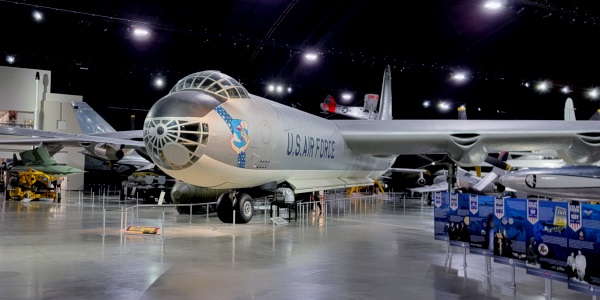
* As America was preparing for World War II in early 1941, there was a fear that Britain would be overrun by Hitler, depriving the US of a forward staging area for Europe. One of the consequences of this mindset was that the US Army Air Corps believed that America might need a bomber that had true intercontinental range, able to fly from North America, attack targets in Europe, and return home without refueling. The Air Corps issued a secret request for proposals on 11 April 1941, specifying a true intercontinental bomber with a range of 16,100 kilometers (10,000 miles); a bombload of 4,540 kilograms (10,000 pounds); a speed of 385 to 485 KPH (240 to 300 MPH); and a ceiling of 10,700 meters (35,000 feet). The bomber would be able to carry a much larger bombload over short distances.
Four companies returned proposals, the winner being the Consolidated "Model 36" -- basically an enlarged derivative of the Consolidated B-32, a heavy bomber that would be produced in small quantities. Consolidated was given a contract for two prototypes of the Model 36 on 15 November 1941. The Model 36 was a huge aircraft, with a wingspan of 70.1 meters (230 feet) and driven by six big radial engines, driving pusher propellers on the back of the wings. The wings were 1.8 meters (6 feet) thick at the roots. The aircraft had a tubular fuselage to ease pressurization, and a twin-fin tail.
By late 1941, the threat of a German invasion of the British Isles had effectively vanished, Germany being preoccupied on the Eastern Front. With the Japanese attack on Pearl Harbor on 7 December 1941, work on the Model 36 went on the back burner while Consolidated churned out PBY flying boats and B-24 bombers needed to fight the war in the here and now. Although a hundred production Model 36 aircraft were ordered on 23 July 1943 -- the need for a long-range bomber to attack Japan brought the Model 36 off the back burner for a time -- the first prototype, the "XB-36", wasn't rolled out until 8 September 1945, and it didn't take to the air for almost a year, performing its first flight on 8 August 1946, with test pilot Beryl A. Erickson at the controls and eight other aircrew on board.
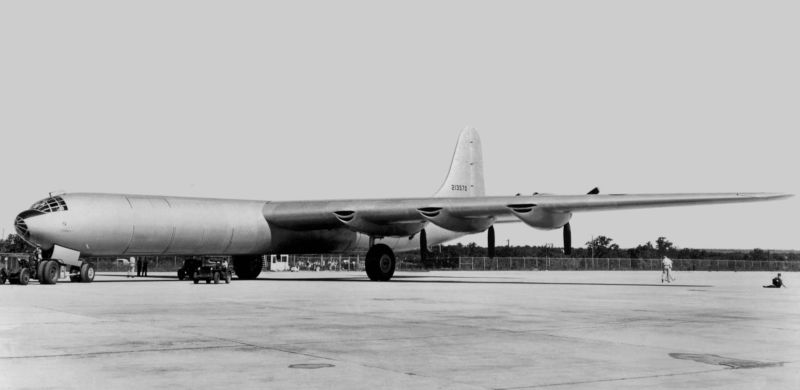
The B-36 was called the "Peacemaker", though it's not clear if that was an official name. That didn't matter, because nobody liked that name; the B-36 would sometimes be called the "Big Stick" -- or the "Magnesium Cloud" as a reference to its construction and high-altitude capabilities. By this time, it wasn't a Consolidated product, since the company had merged with Vultee in 1943 to become the "Consolidated Vultee Aircraft Company". The name was normally abbreviated to just "Convair", though that wouldn't be the "official" name until 1954.
The XB-36 was generally much like the original Model 36 proposal, differing mainly in being fitted with a conventional single-fin tail assembly instead of the twin fins envisioned at the outset. The prototype was unarmed and not fitted with operational kit. It had tricycle landing gear, with single-wheel main gear. The main gear tires were ridiculously huge, with a diameter of 2.8 meters (9 feet 2 inches), and landings were hard on both tires and tarmac. The XB-36 was experimentally fitted with tracked landing gear, but it only flew once in that configuration, the landing gear not holding up well to the exercise.

The second prototype performed its initial flight on 4 December 1947, again with Beryl Erickson at the controls. It was designated "YB-36"; it initially had the single-wheel main gear, but was later refitted with much more practical four-wheel bogies. The YB-36 also had a raised "bugeye" cockpit instead of the conventional cockpit of the XB-36.
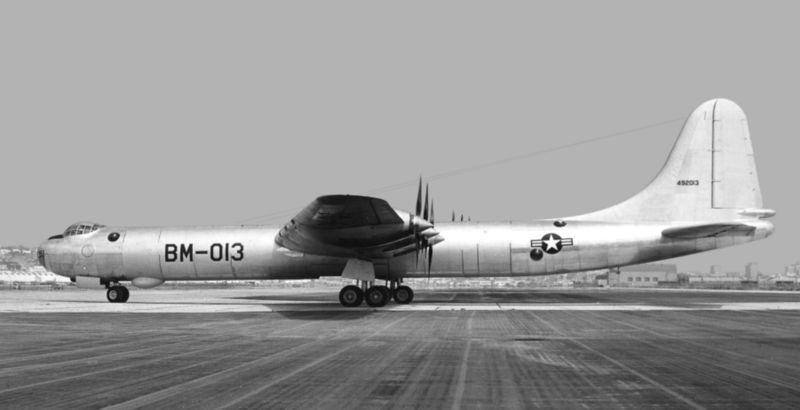
The two prototypes were followed by 22 unarmed evaluation machines designated "B-36A". They weren't all that close to operational spec -- in fact, the first B-36A performed its initial flight on 28 August 1947, well before the YB-36 took to the air. After some misgivings, the US Air Force -- the service having become independent from the Army in that year -- ordered "B-36B" production variants. Initial flight of the B-36B was on 8 July 1948 and 62 were built. Incidentally, sources tend to be confused on the number of B-36Bs, mostly because some of those ordered as one variant ended up being built as other variants.
By the end of 1948, an operational group of B-36Bs had been formed up at Carswell Air Force Base (AFB) in Texas, right next to the Convair plant. Lacking hangars big enough to accommodate the huge B-36s at the time, ground crews were forced to freeze in the winter and roast in the summer as they tried to keep the aircraft flying. Later, mobile shelters were built that could be rolled over the wings to provide some protection from the elements when hangars of adequate size were not available.
To demonstrate the machine's capabilities, on 7 December 1948 the Air Force decided to commemorate Pearl Harbor by flying a B-36B from Carswell to Hawaii, dropping a 4,500-kilogram (10,000-pound) bomb load, and then coming back home, nonstop and unrefueled. The mission took 35 hours 30 minutes of flight time, covering 13,000 kilometers (8,100 miles) at an average speed of less than 370 KPH (240 MPH). On 20 January 1949, five B-36Bs flew from Carswell to overfly Washington DC as part of the inaugural ceremony for President Harry Truman, following his come-from-behind win in the 1948 election.
* The B-36B might well have been the end of the road, since in the summer of 1949 it was at the center of a storm of political controversy that threatened to kill the program. The Truman Administration had just appointed a new secretary of defense, an attorney named Louis A. Johnson; when Johnson was told to make defense cuts, he did so, giving the axe to a US Navy supercarrier named, somewhat redundantly, the USS UNITED STATES.
The Navy did not take kindly to this act. The USS UNITED STATES was the Navy's gambit to give the service a strategic nuclear strike capability. The Air Force wanted to keep control of the nuclear strike mission, with the B-36 as the long-range delivery platform. To complicate matters, Johnson had once been a Convair official -- a conflict of interest that would cause difficulties now, though few paid it much mind then.
The Navy produced a memo that called the B-36 an "obsolete and unsuccessful aircraft" and claimed that Convair had paid off Democratic politicians with millions of dollars. The memo was internal, but by accident or design it ended up in public hands. Navy boosters blasted the B-36 program as a "billion dollar blunder", calling the aircraft a "lumbering cow", saying that all the latest Navy jet fighters could fly rings around it. That was not the case; the B-36 was slow, but with its huge wings it could fly at altitudes above the effective ceiling of most jet fighters. Even if they reached it, the fighters had no maneuverability and the big bomber could easily dodge them.
The USAF hit back, with Secretary of the Air Force Stuart Symington publicly defending the B-36. A Congressional committee investigated the matter, with the Air Force making a thorough case for the B-36, while the Navy fumbled their argument. The conveniently leaked Navy memo backfired when the committee subpoenaed the officials behind it and cut them to ribbons on the witness stand. The "revolt of the admirals", as it was called, had led to a nasty public confrontation, with insults and accusations traded back and forth in the press -- but the end result was that the USS UNITED STATES remained canceled and the B-36 remained alive.
Relations with the USSR had been deteriorating to the point of blatant hostility -- the Soviet blockade of West Berlin beginning in June 1948 had been a real wake-up call -- and the USA needed a long-range bomber to threaten the Soviets with nuclear destruction. The B-36 was the only weapon available to do the job at the time, and so it would be the backbone of the Air Force's Strategic Air Command (SAC) until better delivery platforms then in the pipeline arrived. The Navy would continue to be frustrated by the strategic nuclear strike issue until the late 1950s, when the service began development of the Polaris ballistic missile submarine, a weapon that gave the admirals all the nuclear offensive power they could seriously want. That, however, is another story.
BACK_TO_TOP* The B-36B was built primarily of aircraft aluminum and magnesium. It was powered by six Pratt & Whitney (P&W) R-4360-41 Wasp Major engines -- the spectacular "corncob" air-cooled radials, with 28 cylinders consisting of four banks of seven cylinders in a spiral. The engines provided 2,610 kW (3,500 HP) each. The prototypes and B-36As had featured the less powerful R-4360-25 variant of the engine, with only 2,240 kW (3,000 HP). The Wasp Majors drove oversized three-bladed pusher props with a diameter of 5.8 meters (19 feet) through driveshafts, with a reduction gearing system cutting prop RPM to half that of the engine to keep the proptips from going supersonic. The props were still said to have a rumbling drone that could shake windows when the aircraft was flying far overhead. To support operations from forward airbases, the USAF obtained a special carrier to allow B-36s to haul two spare Wasp Majors. The carrier was fitted into the forward bomb bay, with a pod sticking out to each side of the fuselage to accommodate an engine.
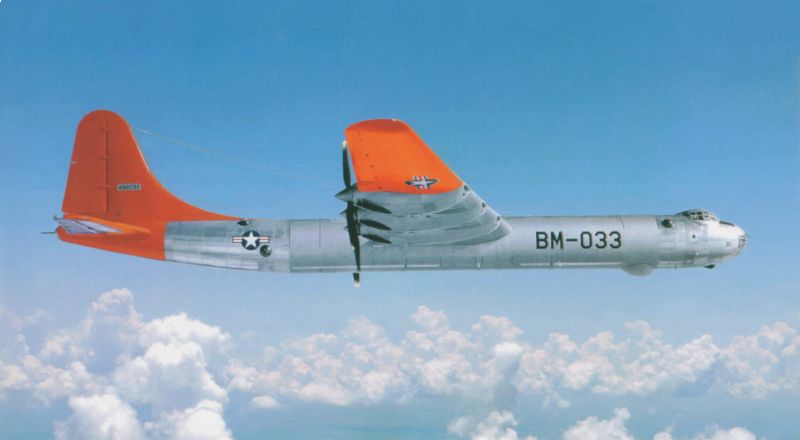
The scale of the B-36 could be considered by realizing that the total area of its control surfaces alone -- flaps, ailerons, rudder, elevators -- was more than the wing area of a B-24 Liberator. The flight control surfaces were, surprisingly, all manually operated, with the pilot shifting small "servo tabs" -- something like trim tabs on the flight control surfaces, but turned into the airstream to drive servos that shifted the control surfaces. The B-36B had four bomb bays, with a tunnel on the lower left side of the fuselage through which a crewman could roll on a trolley to move between the front and back crew sections, laying on his back and pulling himself on a overhead rope.
The B-36B had an optical bombsight, as well as an AN/APQ-23 bombing-navigation radar in a blister under the forward fuselage, integrated with the optical bombsight and an electromechanical analog computer in the K-1 bombing system. As mentioned, the B-36 fleet was tasked with the nuclear strike mission and could carry several fission bombs; from 1953, fusion weapons were available, with the B-36 carrying two Mark 17 "Runts", with a weight of 19,050 kilograms (42,000 pounds) each. B-36s performed several "live drops" of nuclear weapons in test programs. In principle, the B-36 could perform conventional bombing, with stores arrangements running from 132 225-kilogram (500-pound) bombs to two 19,500-kilogram (43,000-pound) T-12 bombs.
The bomber could not only carry a big bombload over long distances, it was also fitted with heavy defensive armament. There were twin M24A1 20-millimeter cannon in both nose and tail positions, with an AN/APG-3 gun-laying radar in a small radome above the tail turret, and six remotely-controlled turrets, again each with twin 20-millimeter cannon. Each cannon had an ammunition supply of 600 rounds. The turrets were retractable, hidden in pairs under doors in normal flight, popping up with one turret to cover the left side of the aircraft and the other to cover the right. There were three of these dual-turret installations on the bomber, with two installations on the top -- one behind the cockpit and the other behind the wing -- and one installation on the belly, just underneath the rear top gun positions. The gunners sighted the guns from six blister positions, two in front, four in the rear. There was no provision for switching control of the turrets between gunners; each gunnery station was dedicated to the control of a particular turret. It seems the cannon system was overcomplicated and not very reliable.

The B-36B was flown by 15 aircrew. The aircrew in the forward section included:
There were five gunners in the rear compartment. The B-36 featured bunks to allow crew members to get some rest on long missions. It also had a head and a galley, with rations heated up the rear section sent forward on the trolley.
BACK_TO_TOP* Complaints about the B-36's performance led Convair engineers to come up with possible tricks to improve performance. A "B-36C" was considered, to be fitted with uprated R-4360-51 engines, which provided an auxiliary "jet exhaust" to increase speed. The new engines would have required changing the configuration from pusher to conventional tractor. However, analysis showed that the performance increase would have been too trivial to be worth the effort, and so the B-36C was never built.
The more practical solution was to add four jet engines along with the six piston engines, resulting in the "B-36D". The prototype was converted from a B-36B, performing its initial flight in its "mixed power" configuration on 26 March 1949. The jet engines were fitted in pairs in pods, with a single pod outboard on each wing. The jet engine pod was basically lifted from the Boeing B-47 Stratojet. It used General Electric J47-GE-19 turbojets, providing 23.1 kN (2,360 kgp / 5,200 lbf) thrust each. The prototype had used similar but less powerful Allison J35 engines.

The jet engines were only used on take-off, and for boost performance in hostile airspace; they provided a significantly shorter take-off run, as well as a useful increment of speed and ceiling. When all the engines were running, aircrews described it as "six turning and four burning". The jet intakes were fitted with an "iris" that closed the engines off to reduce drag from "windmilling" when the turbojets were not in use. Interestingly, in long-range cruise it was not unusual to shut down two, or even three, of the piston engines as well.
The B-36D also featured an astrodome blister on top of the canopy, and "snap action" bomb bay doors, made up of four hinged panels that folded up on themselves, replacing the roll-open bomb bay doors of earlier models. Although the B-36Ds were initially fitted with the K-1 bombing system, they were later refitted with the more sophisticated and reliable K-3A bombing system. The optical bombsight was regarded as redundant and eliminated, with the bombsight panel in the nose faired over with a metal plate. Similarly, the B-36Ds were originally fitted with AN/APG-3 tail radar but were later upgraded to AN/APG-32 tail radar, featuring a "chicklet" style radome. 26 new-build B-36Ds were produced, and 59 of the B-36Bs were rebuilt to B-36D standard. Initial service delivery was on 17 August 1950, to Carswell.
* A strategic reconnaissance version of the B-36D, the "RB-36D", was also built, featuring a manned pressurized module with 14 cameras in the forward bomb bay; up to 80 photoflash bombs in the second bomb bay; a fuel tank in the third bomb bay; and electronic intelligence (ELINT) gear, revealed by an additional antenna fairing under the nose and three fairings under the rear bomb bay. There was some variation in bomb bay configurations among the RB-36 machines; they could also in principle carry bombloads.

24 new-production RB-36Ds were delivered -- some sources mention conversions from B-36Bs, but these were merely machines that had been ordered as B-36Bs and not built as them. Initial delivery of the RB-36D was on 3 June 1950.
* In addition, 21 B-36As and the YB-36A were upgraded to a standard similar to that of the RB-36D, and given the designation "RB-36E", the first being flown on 18 December 1950. The reconnaissance variants tended to carry large crews, of up to 22, to handle the photographic and ELINT systems.
From the mid-1950s, a "Featherweight" program was conducted to strip out gear from selected B-36s to improve their ceiling. There were "class II" Featherweights that retained their defensive armament, and "class III" Featherweights in which all the defensive armament except for the tail position, with the gunner's blisters either faired over or replaced with flush windows.
BACK_TO_TOP* The "B-36F" was similar to the B-36D, but with uprated P&W R-4360-53 engines with 2,835 kW (3,800 HP) each. The K-3A bombing system and AN/APG-32 tail radar were standard, and a chaff dispenser system was later added. Initial flight was on 28 November 1950, with 34 built. 24 "RB-36F" reconnaissance machines with increased fuel load were also produced.
The "B-36H" was another stepwise refinement of the breed, with an improved flight deck, AN/APG-41A tailgun radar -- featuring twin side-by-side radomes, which no doubt invited comparisons to a brassiere -- and other small changes. Initial flight was on 5 April 1952, and a total of 83 was built, as well as 73 "RB-36H" reconnaissance machines.
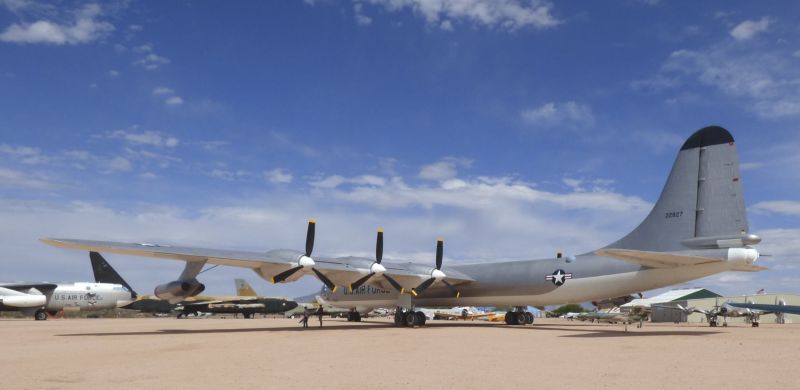
The final production version of the B-36 was the "B-36J" -- there was no "B-36I", the Air Force didn't use "I" as a suffix since it could be confused with a "1". It featured additional wing tanks and reinforced landing gear to handle higher gross weights. Initial flight was on 3 September 1953, with 33 built; all ended up in Featherweight configuration. The last of the batch, the last of 383 B-36s to be built, was delivered to the Strategic Air Command on 14 August 1954. SAC was effectively the B-36's only user; it was never flown by anyone else.
___________________________________________________________________
CONVAIR B-36J:
___________________________________________________________________
wingspan:
70.1 meters (230 feet)
wing area:
443.3 sq_meters (4,772 sq_feet)
length:
49.4 meters (162 feet 1 inch)
height:
14.22 meters (46 feet 8 inches)
empty weight:
77,580 kilograms (171,035 pounds)
loaded weight:
181,975 kilograms (410,000 pounds)
max speed at altitude:
660 KPH (410 MPH / 355 KT)
service ceiling:
12,160 meters (39,000 feet)
range:
10,950 kilometers (6,800 MI / 5,915 NMI)
___________________________________________________________________
The B-36 did not remain in service long, being phased out in the late 1950s. The type was officially retired on 12 February 1959. The last flight of a B-36 was on 30 April 1959, when a B-36J was flown to Wright-Patterson AFB in Ohio, to take up residence in the Air Force Museum, where it still lives today.
* Some crews had fond memories of the B-36, but there were those who hated the thing, and even those who liked it had their horror stories about it. One pilot who called it a "big, wonderful old bird" but said piloting it was "like sitting on your front porch and flying your house around." A less enthusiastic pilot called it a "horrible, lazy beast to fly".
When it crashed, its magnesium construction made for a spectacular and thorough fire. At least nine were lost in accidents. There was also a disastrous incident at Carswell on 1 September 1952, when a tornado ripped across the flightline and damaged 71 B-36s, disabling half of SAC's heavy bomber fleet. 51 of the aircraft were back in service by early October, but the rest had to be rebuilt, with one completely written off.
The B-36's major virtue was its long range, though in practice not as long as had been desired, and in its Featherweight manifestations it could operate well above the reach of enemy defenses of its era. B-36s didn't fly combat missions during the Korean War -- heavy bombing could be performed by Boeing B-29s, the B-36 being reserved for the strategic bombing mission -- but RB-36s performed overflights of Red China and possibly the USSR. The details of these missions were kept secret and remain unclear; there were no losses, and no doubt the defenders were frustrated at watching the Magnesium Clouds fly far overhead.
As far as the B-36's usefulness as a nuclear deterrent went, that could be argued -- but since the B-36 never dropped a bomb in anger, the argument cuts both ways, and it seems that uncertainty afflicted the Soviets as well. Even an ineffective deterrent works if adversaries don't want to push their luck.
BACK_TO_TOP* From 1942, even as Consolidated was (slowly) working on getting the XB-36 out the door during World War II, the company was considering a transport version of the bomber, the "Model 37". The plan was to use the same wings, engine, tail, and many subsystems of the XB-36 mated to a double-decker fuselage, with seating for 400 troops, rivaling a modern jumbo jet.
As with the XB-36 itself, development of the Model 37 was a low priority, and the sole prototype, designated the "XC-99", didn't fly until 23 November 1947. By that time, the military had decided they didn't need such a big cargolifter after all, and the airlines had lost interest in the concept. However, the single prototype did go into service with the Air Force, acquiring a nose radome, and remained in operation until 1957.

* Given the concerns over the low performance of the B-36, not too surprisingly Convair engineers investigated a variant with all-jet propulsion and swept wings, originally designated the "B-36G". This dovetailed with USAF plans to obtain a jet-powered strategic bomber, and the service was interested enough to award a contract for two prototypes, designated "YB-60", on 15 March 1951.
The first YB-60 prototype flew on 18 April 1952. It was a very distinctive aircraft -- some claim downright ugly -- mating the B-36 fuselage to swept wings and tail. It was powered by eight P&W J57 turbojets, each providing 38.7 kN (3,945 kgp / 8,700 lbf) thrust, mounted on a total of four pylons under the wings in twin-engine pods. After some fiddling, the decision was made to reduce defensive armament to the tail turret. Crew was accordingly reduced to five.
The Air Force was actually much more interested in the new-design Boeing B-52, and was only interested in the YB-60 as a cheap-and-dirty backup solution in case the B-52 program went off track. It didn't, the YB-60 was inferior to the B-52 in most respects, and that was the end of it. Both YB-60 prototypes were scrapped.

* One of the more unusual branches of the B-36's history was its use in "parasite fighter" experiments, in which the bomber was supposed to carry its own escort fighter into hostile territory. Once again, the exercise was provoked by concerns over the B-36's vulnerability. The initial idea was to develop a very small fighter, the McDonnell "XF-85 Goblin", that would fit into a B-36 bomb bay. One Goblin would be carried along with the B-36's bombload, though there were schemes to fit some B-36s as "flying aircraft carriers" with three Goblins. The Goblin development program went poorly, and the little fighter was quickly seen to be inadequate in any case.
However, the Air Force remained interested in the concept under the name of "Fighter Conveyor (FICON)". At least 12 RB-36Fs were modified to "GRB-36F" standard, with a trapeze system in the bomb bay to carry, drop, and pick up an GRF-84F Thunderflash reconnaissance jet with a snag hook on the nose. Flight experiments with the GRB-36F and GRF-84F began in May 1953. The scheme went into formal service in the mid-1950s for about a year; there are mixed reports on how well it worked in practice. FICONs are suspected to have flown some long-range penetration missions over the Eastern Bloc, though no open records confirm it.
Another scheme, known as "TOM-TOM" for some obscure reason, involved fitting a connector to each wingtip of an RB-36F that would allow an RF-84F Thunderflash reconnaissance aircraft to link its wingtip to the RB-36F for a "tow". Experiments were conducted in 1953, but the scheme was dodgy, particularly because wingtip turbulence from the RB-36F made life very troublesome for the Thunderflash pilots, and TOM-TOM was abandoned.
* There were a number of other special mods of the B-36:
One of the most unusual modifications was the "atomic" B-36. The US was completely atom-crazy in the 1950s, and accordingly the Air Forced began a program to develop an atomic-powered aircraft. As a first step, a B-36H was converted into a test bed, the "NB-36H", which carried a nuclear reactor. The reactor didn't power anything, the whole purpose of the exercise being to determine how well a reactor could be flown around in an aircraft. This particular B-36H had been one of the victims of the tornado attack on Carswell in September 1952 and needed to be rebuilt in any case.
The NB-36H was fitted with a new crew compartment with a distinctive nose and cockpit and radiation shielding to protect the crew. The cockpit glazing was leaded glass up to 30 centimeters (a foot) thick; the crew was so isolated that they couldn't hear the outside world. Close-circuit TV links allowed them to keep an eye on the reactor and the engines. The NB-36H was given a spiffy paint job -- detailing over bare metal -- and named "Crusader".
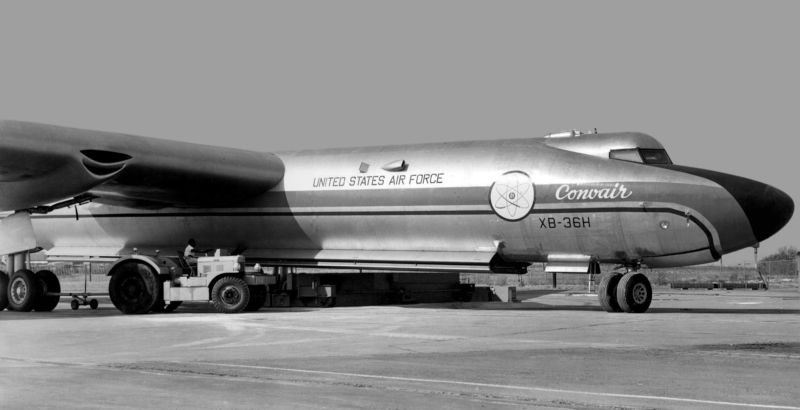
First flight of the NB-36H was on 17 September 1955. On flights, it was shadowed by a transport carrying a load of Marine paratroopers who were to jump and secure the area if the NB-36H had to perform an unscheduled landing at a remote location, or crashed; they were called the "glow in the dark" crew. A fully nuclear-powered version, the "X-6", was to follow, but (in hindsight unsurprisingly) the Air Force realized that flying nuclear reactors around was a bad idea and gave up on the concept, with the final flights in March 1957.
* The following list summarizes B-36 variants and production:
Total production of the B-36 was 383 aircraft.
BACK_TO_TOP* The Air Force operated B-36s in my hometown of Spokane, Washington, in the mid-1950s, when I was just a toddler. It would seem that I might have been impressed at that age by the loud machine flying above my head, but unfortunately I have not the least memory of it. Intriguingly, they operated some of the FICON machines. Fairchild got rid of the B-36s when I was only about three years old, so I guess it's not surprising I don't recall it. I do remember it from the 1950s "flyboy" movie STRATEGIC AIR COMMAND, starring Jimmy Stewart, who was actually an Air Force officer and had flown bombers in World War II. The movie has some nice footage of aircraft of the time, and I recall being particularly fascinated at watching the crew of the B-36 shuttle through the bomb bay tunnel on a trolley.
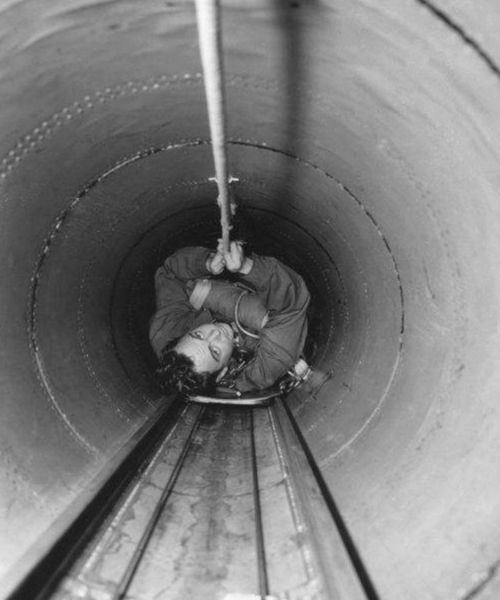
* There's a story that gets circulated in documents on the B-36 that there was a tunnel that went out in the wings through which a mechanic could crawl to perform inflight repairs. Exact details of this feature are unclear; I have received entirely contradictory descriptions of it from people who claimed to have been B-36 aircrew. The details are uninteresting, the only amusing thing about the matter being its demonstration of just how untrustworthy the information I receive from emails really is.
* Sources include:
* Illustration credits:
* Revision history:
v1.0.0 / 01 nov 08 v1.0.1 / 01 dec 08 / Fix on wing tunnel myth as per Tom Drennan. v1.0.2 / 01 nov 10 / Review & polish. v1.0.3 / 01 apr 11 / Minor fixes. v1.0.4 / 01 mar 13 / Review & polish. v1.0.5 / 01 mar 13 / Review & polish. v1.0.6 / 01 feb 15 / Review & polish. v1.0.7 / 01 jan 17 / Review & polish. v1.0.8 / 01 dec 18 / Review & polish. v1.0.9 / 01 oct 20 / Review & polish. v1.1.0 / 01 oct 22 / Illustrations update. v1.1.1 / 01 sep 24 / Review & polish. (+)BACK_TO_TOP
